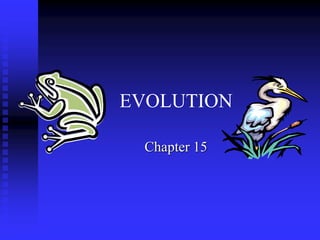Evolution.ppt
•Download as PPT, PDF•
0 likes•16 views
This document provides an overview of Charles Darwin's theory of evolution by natural selection. It discusses Darwin's voyage on the HMS Beagle where he observed differences in species between locations, collected fossils, and studied organisms in the Galapagos Islands. Darwin noticed traits varied between related species and populations. This led him to hypothesize that species slowly change over generations through natural selection, where individuals better suited to the environment are more likely to survive and pass on their traits.
Report
Share
Report
Share

Recommended
More Related Content
Similar to Evolution.ppt
Similar to Evolution.ppt (20)
Biology - Chp 15 - Darwins Theory Of Evolution - PowerPoint

Biology - Chp 15 - Darwins Theory Of Evolution - PowerPoint
Evolution natural selection_and_speciation 6 kings

Evolution natural selection_and_speciation 6 kings
Evolution, Natural Selection, Taxonomy, and Anthropology

Evolution, Natural Selection, Taxonomy, and Anthropology
Recently uploaded
Recently uploaded (20)
Mammalian Pineal Body Structure and Also Functions

Mammalian Pineal Body Structure and Also Functions
Constraints on Neutrino Natal Kicks from Black-Hole Binary VFTS 243

Constraints on Neutrino Natal Kicks from Black-Hole Binary VFTS 243
THE IMPORTANCE OF MARTIAN ATMOSPHERE SAMPLE RETURN.

THE IMPORTANCE OF MARTIAN ATMOSPHERE SAMPLE RETURN.
A Giant Impact Origin for the First Subduction on Earth

A Giant Impact Origin for the First Subduction on Earth
biotech-regenration of plants, pharmaceutical applications.pptx

biotech-regenration of plants, pharmaceutical applications.pptx
Circulatory system_ Laplace law. Ohms law.reynaults law,baro-chemo-receptors-...

Circulatory system_ Laplace law. Ohms law.reynaults law,baro-chemo-receptors-...
Detectability of Solar Panels as a Technosignature

Detectability of Solar Panels as a Technosignature
word2vec, node2vec, graph2vec, X2vec: Towards a Theory of Vector Embeddings o...

word2vec, node2vec, graph2vec, X2vec: Towards a Theory of Vector Embeddings o...
National Biodiversity protection initiatives and Convention on Biological Di...

National Biodiversity protection initiatives and Convention on Biological Di...
Evolution.ppt
- 2. In your own words, describe what YOU think the theory of evolution means…
- 3. Misconceptions about Evolution Evolution does not tell us about how life first appeared on Earth Individuals do not evolve. Only populations can evolve. Not all changes are “good” Changes that happen to a person in their lifetime do not always get passed on to their children Evolution is not a ladder working towards a better species
- 5. Darwin’s Theory of Evolution Evolution, or change over time, is the process by which modern organisms have descended from ancient organisms.
- 6. Voyage of the Beagle
- 7. Voyage of Beagle Dates: February 12th, 1831 Captain: Charles Darwin Ship: H.M.S. Beagle Destination: Voyage around the world. Findings: evidence to propose a revolutionary hypothesis about how life changes over time
- 9. Patterns of Diversity Darwin visited Argentina and Australia which had similar grassland ecosystems. those grasslands were inhabited by very different animals. neither Argentina nor Australia was home to the sorts of animals that lived in European grasslands.
- 10. Patterns of Diversity Darwin posed challenging questions. Why were there no rabbits in Australia, despite the presence of habitats that seemed perfect for them? Why were there no kangaroos in England?
- 11. Living Organisms and Fossils Darwin collected the preserved remains of ancient organisms, called fossils. Some of those fossils resembled organisms that were still alive today.
- 12. The Galapagos Island Darwin was fascinated in particular by the land tortoises and marine iguanas in the Galápagos. Giant tortoises varied in predictable ways from one island to another. The shape of a tortoise's shell could be used to identify which island a particular tortoise inhabited.
- 13. Animals found in the Galapagos Land Tortoises Darwin Finches Marine Iguanas
- 14. The Journey Home Darwin Observed that characteristics of many plants and animals vary greatly among the islands Hypothesis: Separate species may have arose from an original ancestor
- 15. Lamarck
- 16. Lamarck’s Theory of Evolution Tendency toward Perfection(Giraffe necks) Use and Disuse (bird’s using forearms) Inheritance of Acquired Traits Are you still paying Attention?
- 18. Publication of Orgin of Species Russel Wallace wrote an essay summarizing evolutionary change from his field work in Malaysia Gave Darwin the drive to publish his findings
- 19. Natural Selection & Artificial Selection Natural variation--differences among individuals of a species
- 20. Peppered Moth • The Peppered Moth is an example of Natural Selection • During the Industrial Revolution the trees on which the moth rested became covered. • This selected against the allele for pale color in the population (which were poorly camouflaged from predators) and selected for the dark colour allele
- 21. Evolution by Natural Selection The Struggle for Existence-members of each species have to compete for food, shelter, other life necessities Survival of the Fittest-Some individuals better suited for the environment
- 22. Natural Selection Over time, natural selection results in changes in inherited characteristics of a population. These changes increase a species fitness in its environment
- 23. Descent Descent with Modification-Each living organism has descended, with changes from other species over time Common Descent- were derived from common ancestors
- 24. Evidence of Evolution The Fossil Record Geographic Distribution of Living Things Homologous Body Structures Similarities in Early Development
- 26. Evidence for Evolution Vestigial organs-organs that serve no useful function in an organism i.e.) appendix, miniature legs, arms
- 29. Summary of Darwin’s Theory Individuals in nature differ from one another Organisms in nature produce more offspring than can survive, and many of those who do not survive do not reproduce.
- 30. Summary of Darwin’s Theory Because more organisms are produce than can survive, each species must struggle for resources Each organism is unique, each has advantages and disadvantages in the struggle for existence
- 31. Summary (cont.) Individuals best suited for the environment survive and reproduce most successful Species change over time
- 32. Summary (cont.) Species alive today descended with modification from species that lived in the past All organisms on earth are united into a single family tree of life by common descent